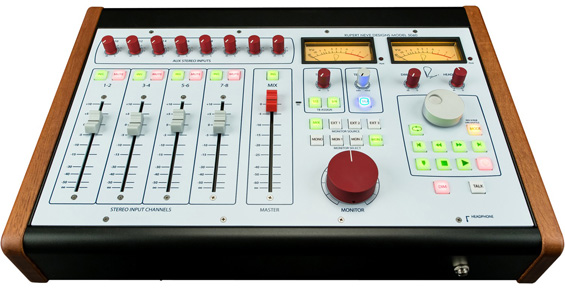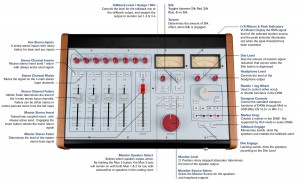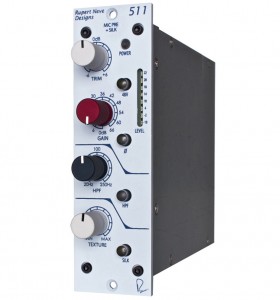Double-Feature Review: Rupert Neve Designs 5060 Centerpiece Mixer & 511 Mic Pre
Couple months back, I was invited to Downtown Studios for the unveiling of a new Rupert Neve mixer. I knew it would be small – I’d read rumors of a desktop mixer with the guts of the 5088 console. And it was the size, perhaps, which piqued my curiosity the most. Could this be the scaled-down (in size and price) mixing answer small studio owners have been dreaming of?
What they revealed was the compact and beautiful Rupert Neve 5060 Centerpiece mixer. And to see it, I thought for sure, this could be the answer. Or, at least, that this was Rupert Neve’s answer.
What Is It?
Basically, the 5060 is a 24-input line mixer with the mix buss from the 5088 console, including an insertable “Silk” circuit with two modes. It has a full center section with three monitor outputs, Mono and Dim, three external inputs, and Talkback to two outputs. It also has a full USB / MIDI transport controller built-in, including a Shuttle/Jog wheel, and a very high quality headphone amp.
The mixer section has four 100mm stereo faders that control inputs 1-8, with each fader having insert and mute. These inputs are each switchable to mono if desired. Above the four faders are 8 stereo rotary faders for stereo inputs 9-16 and to the right is a Master fader that sets the level of the mix into the master buss. A set of large stereo VU meters with peak indicators help you keep track of the RMS level of whatever is being monitored.
The 5060 is an amazing piece of gear to behold. The large solid unit is very high quality, no expense seems to have been spared in building this drool-worthy mixer. The faders are long (no puny 60mm faders here) and top quality; they seem like they would last forever. The buttons are mostly backlit and click with reassuring solidity. The master monitor knob is stepped and huge; there’s no mistaking which knob controls the main volume. Nice touches abound here – wood sides, different colored backlighting for the two Silk modes, silent built-in fan, weighted jog/shuttle wheel.
It’s kind of like sitting down into a new Mercedes, it feels like it’s built like a bank vault and every piece has been considered and carefully selected. This is not something you’ll feel like replacing anytime soon.
And The Sound?
OK, so it’s amazing to paw at, but what does it sound like? Shane at Alto Music graciously allowed me to borrow one (thanks Shane!) to try out in my studio, and I took full advantage of his generosity.
A little about my mix setup: I currently use a 32-channel passive mixer out of an Antelope Orion DA. A passive mixer drops the signal level quite a bit, so typically I’ll use a pair of mic pres to bring it up to line level for the final A/D conversion. The choice of mic pres will color (or not) the sound. I already use 25-pin Dsubs to run audio around my rig, so dropping the 5060 into my setup was fairly easy. I just ran the lines out of the Orion straight into the 5060 and then back into a Universal Audio Apollo, my normal choice for mic pres and A/D conversion. While normally I use the Apollo’s mic pres, this time I ran it straight into the line ins, since the 5060 already is running at line level.
I was towards the end of mixing a song for the band Haunted Hauses, a fairly complex song (over 100 tracks) with a big low end but also a lot of distortion and grit on various instruments, even a bit on the vocals. Getting the mid-range right on mixes like this is always tricky, balancing power with clarity, retaining the low boom and enough air on top being critical.
I had already basically finished the mix, mixing into the Apollo with Neve 1073 emulation on the mic pres. The band and management were both pleased with the results.
Running this mix straight through the 5060 sounded great: nice and full, loads of low end, open on the top, really nice. But not that different from the original mix. It got more interesting when I engaged the Silk circuit on the mix buss – a lot more interesting. I’ve done a ton of mixing on the Stratosphere Studios (R.I.P.) Neve 8068, and pushing that mix buss hard was always the key to getting a great mix, especially if the material had a healthy amount of distortion. The 5060 worked exactly the same way, with the Silk “Red” engaged, and the Texture set to about halfway, the more I hit the mix buss, the better it sounded. I could basically beat the mix I had going within an hour of playing with this new mixer, which is definitely amazing on a heavy complex mix like this. If I had started with this mixer from the beginning, I probably could have even pushed it further into sonic nirvana (nerdvana?).
The Silk circuit has two modes: Red and Blue. The Red mode accentuates the saturation in the high-mids and highs, while the Blue mode features more saturation in the lows and low mids. To my ears, the Red mode sounds more like an 8068 when pushed, while the Blue mode sounds more like a vintage American desk, like an older MCI or even a custom API. According to Rupert Neve Designs, this circuit “reduces the amount of negative feedback (I need this ability in the comments section!) on the output transformer, increasing harmonic content as the texture knob is turned up.” Whatever that means, the end result sounds really, really cool. Especially for complex distortion like in the mix I was doing for Haunted Hauses.
All in all, this thing rocks! I mean it works wonders on rock music and if you can make the investment it will transform (with Rupert Neve custom transformers) your workflow. If I had one of these full-time I would work faster and get higher quality work done more quickly.
How Much?
This is the part in most reviews where I ask, ok, it’s great, sounds cool, how much is it? Before I answer, it’s important to remember that you are basically getting the guts of a Rupert Neve 5088 console, with monitor section, master buss, Silk controls, etc. made just for mixing. No mic pres or EQs here, nor any slots to add them in, just the essential hardware to elevate your DAW setup to a high-functioning mixing workstation.
The MSRP for this is $7,995, and I personally think it’s worth every penny. Some mid-size studio owners might balk at that price, but I believe this unit would make an instant mix room with unassailable quality. You would have a serious Rupert Neve mixer in your hands for under eight grand.
Keep in mind it’s also expandable with the 5059 Satellite unit, which adds 16 more line inputs plus inserts and more Silk circuits.
I believe Rupert Neve has a massive mixer on its hands here. A massive mixer in a very small footprint. The build quality is absolutely amazing, and the sound is gorgeous. It’s a studio centerpiece of the highest caliber.
Next Up: The Rupert Neve 511 Mic Pre
Now, having said all that, I personally already have a high-quality monitor controller, a 32-channel passive mixer, a Pro Tools controller, a high-end headphone amp, and nice metering. So, were I to purchase the 5060, I would have a lot of extraneous gear on my hands. So, the question for my particular studio was: how do I get that dreamy tone without having to replace most of my setup? Enter the Rupert Neve 511 mic pre.
The Rupert Neve 511 is a 500 series mic pre, similar in design to the Rupert Neve 517 but with the Silk “Red” circuit and Texture control from the 5060 and Portico II channel strip. It incorporates a continuously variable high pass filter, sweepable from 20hz up to 250hz. It also has all the normal things a mic pre needs, including 48v phantom and phase switch, but unlike most in this price range it has an 8-segment LED level meter for the mic pre output.
I got a pair of these (again from Shane of Alto Music) just as I was tracking a band from Cincinatti called Tweens. This band is an awesome three-piece punk band with a ferocious female singer/guitarist who sounds not unlike Kathleen Hanna or Dale Bozzio. This band also LOVES distortion.
Their initial demos were sound bombs of pure energy and excitement, everything distorted beyond reason, and sounded amazing. Our idea for the record was to make something with similar energy but perhaps with a bit more sound quality. It was a given that the vocals would be distorted, going in and probably during mixing as well. I decided to try out the 511 on the singer’s voice first, and see if the Silk circuit could draw some fuzzy goodness out of her vocal prowess.
Her vocals sounded awesome and huge, very open and full sounding at first. I started adding the Silk texture, a little at first but then cranking it all the way. The sound was saturated and lush, but not distorted enough for their liking. This mic pre is not a distortion pedal after all. It’s big and fat, and can get some great complex tones, but you wouldn’t mistake it for a distortion plugin or pedal. It’s too nice.
When I got to the mixing stage, I plugged a pair of 511s after my passive mixer and tried the Silk circuit again, turning the Texture knob about halfway. This time is worked beautifully. The heavy distortion on the guitars, bass, drums and vocals (yes, everything had some) really sang through the Silk of the 511s. I finally had found a nice console saturation in analog format! This was the mic pre to use on this album, complimenting the in-your-face sound of the band perfectly.
As an experiment, I tried running some mixes of a country/bluegrass record I recently finished through the 511s as well. This material is not distorted at all – it’s a simple recording of drums, acoustic bass, acoustic guitar and some dobro, with harmonizing female and male lead vocals.
How would the Silk treat it? As it turns out, very nicely.
For whatever reason, I really liked what the circuit did to the voice and dobro, and switching it in and out really made it sound better. (The Silk circuit at halfway boosts the output around 2.5db, but I compensated for that while testing). I ended up running all the mixes through the 511s before sending them off to mastering and it sounded great.
The Rupert Neve Silk “Red” circuit has found a new home in my mix setup and is definitely worth the money. I doubt I’ll ever mix without them again! They sell for around $550 street, a big bargain in my opinion.
Click HERE for more details on the Rupert Neve Designs 511 Mic Pre, and HERE for more on the 5060 Centerpiece Mixer. Call Shane Koss at Alto Music NYC if you’re interested in checking out either product at Alto’s NYC studio showroom.
Eli Janney is a Brooklyn-based mixer/producer who has worked with The Big Sleep, Ryan Adams, Wilco, Obits, and The Soft Pack. He is also bass player/keyboardist in the band Girls Against Boys.
Please note: When you buy products through links on this page, we may earn an affiliate commission.









